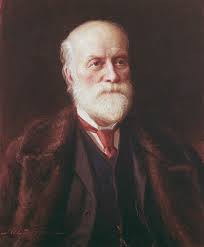Get Today in Masonic History into your Inbox. Sign up today for one of our email lists!
Need an article for your Trestleboard/Newsletter see our Use Policy
Sanford Fleming is Born

Today in Masonic History Sanford Fleming is born in 1827.
Sanford Fleming was a Scottish born Canadian engineer and inventor.
Fleming was born in Kirkcaldy, Scotland on January 7th, 1827. At the age of 14 he began apprenticing as a surveyor.
In 1845, at the age of 18, Fleming and his brother, David, emigrated to colonial Canada. They traveled through several cities in Canada, Quebec City, Montreal and Kingston to name a few. Finally they arrived in Peterborough where they stayed with cousins.
In 1849 Fleming became qualified as a surveyor in Canada. The same year Fleming and a group of his friends started the Royal Canadian Institute. The organization was originally intended as a group for professional engineers and surveyors. The group quickly evolved to be all encompassing of the sciences.
In 1851, Fleming designed the Threepenny Beaver, Canada's first postage stamp.
In the time leading up to 1855 while Fleming was helping to found the Royal Canadian Institute and designing his postage stamp, he was also working for the Grand Trunk Railway. The rail system extended down into New England and New York in the United States and operated in eastern Canada.
In 1855, Fleming became the Chief Engineer of the Northern Railway of Canada. While the Chief Engineer, he advocated for the construction of iron bridges instead of wooden bridges for safety reasons.
In 1863, Fleming became the chief government surveyor for Nova Scotia. He was tasked to build a line form Truro and Pictou. Refusing to accept the tenders from contractors he considered too high, he eventually was able to bid on the job himself and finished the line in 1867 saving the government money and making himself a profit.
Before beginning the Truro and Pictou line, in 1862, Fleming put forth a plan for the transcontinental railway (eventually to be called the Canadian Pacific Railway) connecting the Atlantic and Pacific coasts. It wasn't until 1867 the project got underway, in part because of the American Civil War and the unreliable nature of getting from New Brunswick and Nova Scotia by going through Maine.
As part of the Canadian Pacific Railway, in 1872 Fleming headed west with a party to survey the route for the line. By 1880 more than 600 miles of the line had been laid. It was at this time Canada experienced a shift in government. Many in the political system felt the Canadian Pacific Railway should be in private hands and Fleming was dismissed. It was quite possibly the hardest blow of Flemings life. By 1884 though he had become the Director of the Canadian Pacific Railway and was there when the final spike was driven in.
In 1876 after a missing a train in Ireland because the schedule showed the departure time as P.M. instead of A.M., Fleming started pushing his idea for time zones. Calling his idea Cosmic Time and like Universal time his time zones were linked to the anti-meridian (180°) going through Greenwich, England. He pitched his idea to the International Meridian Conference of 1884. The conference accepted Universal time, and reject Fleming's idea for time zones, calling it a "local problem". By 1929, 14 years after Fleming's death, most of the world adopted time zones.
Sanford passed away on July 22nd, 1915.
Fleming was a member of St. Andrew's No. 16 in Toronto, Ontario.
This article provided by Brother Eric C. Steele.

